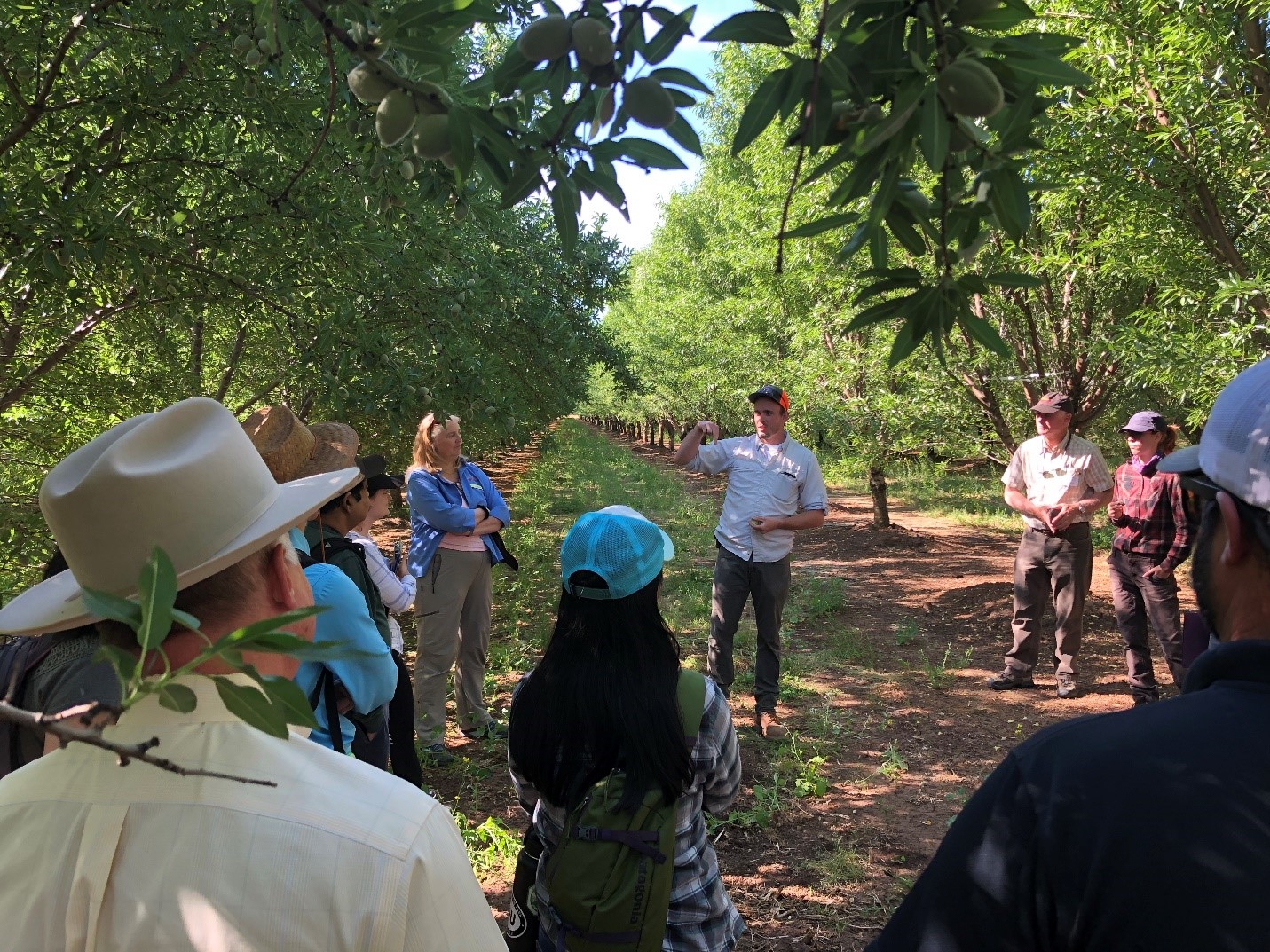Quick: Thirty officials from the CalEPA, the Department of Pesticide Regulation, Department of Conservation and other California agencies show up at your orchard on a Friday morning. What do you do?
 Rory Crowley, host of this year’s Environmental Stewardship Tour, spoke to attendees about various practices he implements to benefit his trees and the environment, including planting cover crops.
Rory Crowley, host of this year’s Environmental Stewardship Tour, spoke to attendees about various practices he implements to benefit his trees and the environment, including planting cover crops.
- Hang out the “gone fishin’” sign and head out the back way.
- Call your Pest Control Advisor, farm advisor and a good lawyer.
- Invite them to stay for coffee and conversation about the challenges facing growers today.
If you answered “C” you might make a good host for next year’s Environmental Stewardship Tour with the Almond Board of California (ABC).
Since 2004, the Almond Board has hosted regulators from key departments in state, local and federal government agencies to tour almond orchards and handling facilities to get a firsthand look at how almonds are grown and processed, and to and hear directly from the people facing the challenges of growing almonds in the Central Valley every day.
The primary goal of the tour is to help environmental regulators understand the basics of what it takes to grow almonds — such as variety and rootstock selection, irrigation, nutrient and pest management — and the issues growers are considering in their day-to-day decision-making. This year’s host, Rory Crowley of Nicolaus Nut Company near Chico, was eager to showcase the work he and his wife and family are doing to be good stewards of the resources we have to grow food. Crowley gave many tangible examples of the thinking that goes into figuring out how to grow well for the trees and the environment — such as planting cover crops and investing in pheromone puffers for navel orangeworm mating disruption — and how to ensure make some money in the process.
In addition, Nicolaus Ranch has been a grower cooperator on a number of research efforts. Two years ago, Nicolaus Ranch signed up to participate in a field trial with researchers at the University of California, Davis, to test the long term impact on soil health of replacing chemical fumigants with biosolarization, also known as anaerobic soil disinfestation (ASD). This process uses added carbohydrate organic matter — in this case almond hulls and shells — with flooding, and tarping for solarization to reduce soil pests. With support from the Almond Board and the Western Center for Agricultural Health and Safety, researchers hope to show that biosolarization is not only an effective alternative to fumigants for some situations but also improves soil health over the life of an orchard.
During the tour UC Davis Graduate Student Researcher Emily Shea gave an overview of the research and results to date, which appear to validate that biosolarization is an effective alternative for replant disorder and possibly also nematodes. Crowley explained why this project is important to him and the Nicolaus family.
“As you can see, this orchard is next to a residential neighborhood, which at the time of replanting included a childcare facility, so fumigation was not an option,” said Crowley. “But it’s not just about following regulations. We also live and work here every day. Finding safer and more environmentally friendly ways to control pests in our own backyards isn’t an option, it’s an obligation.”
ABC Director of Sustainability and Environmental Affairs, Gabriele Ludwig, says biosolarization could also help the industry meet two of the Almond Orchard 2025 Goals: increasing the adoption of environmentally-friendly pest management tools and achieving zero waste from the orchard. Ludwig reviewed the industry-wide goals, adopted in 2018 by the ABC board of directors, as well as the California Almond Sustainability Program.
The tour ended with a visit of North State Hulling Cooperative in Chico. Mayo Ryan, general manager, gave the group a glimpse into the future with an overview of the coop’s plan to build a state-of-the-art hulling facility that will include a furnace to turn hulls and shells into biochar, a soil amendment, while generating heat to dry almonds, addressing a key roadblock to advancements in off-ground harvest.
Attendees of the Environmental Stewardship Tour expressed appreciation for the opportunity to spend a day learning about how policies set by their departments impact growers and processors of almonds.